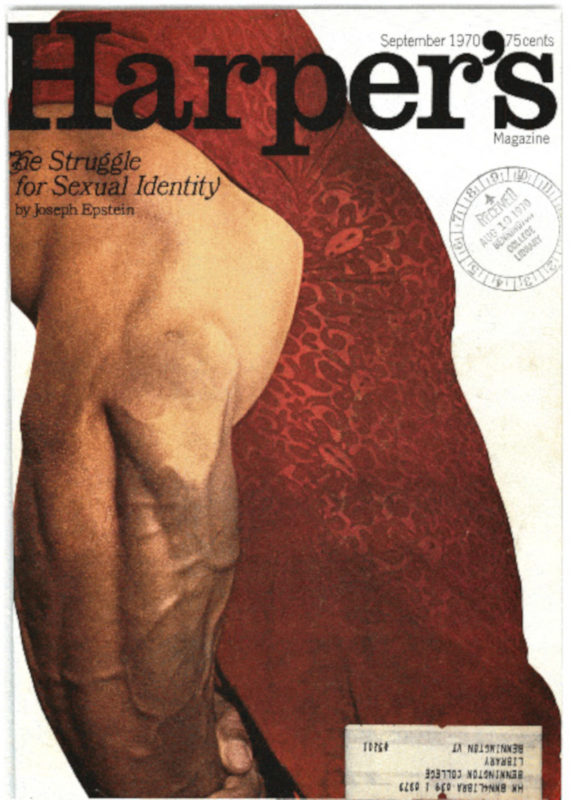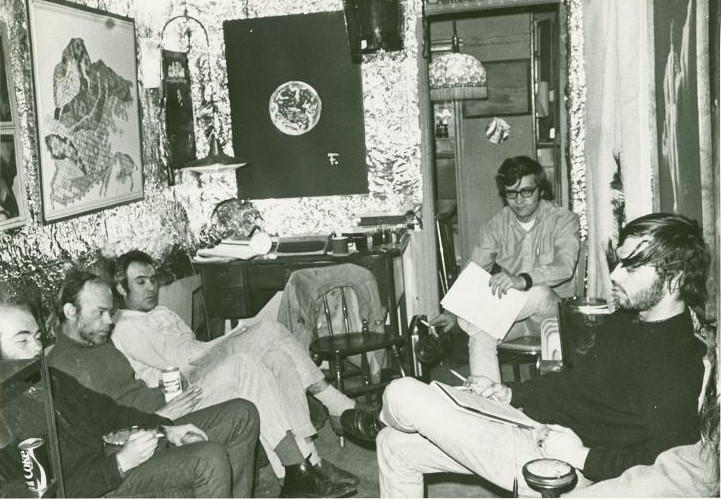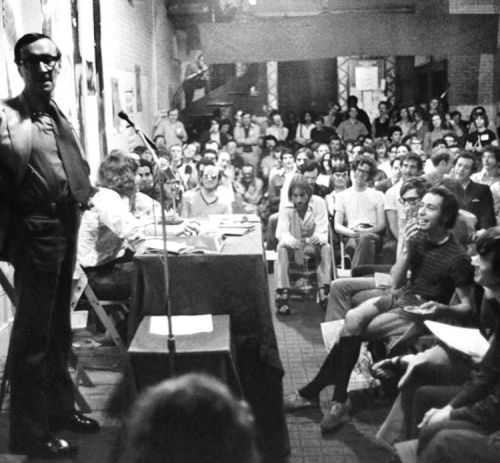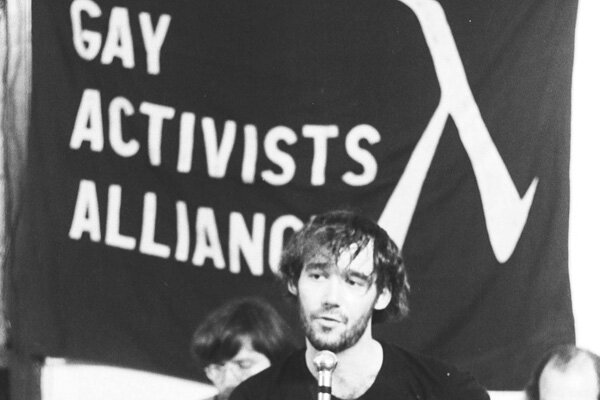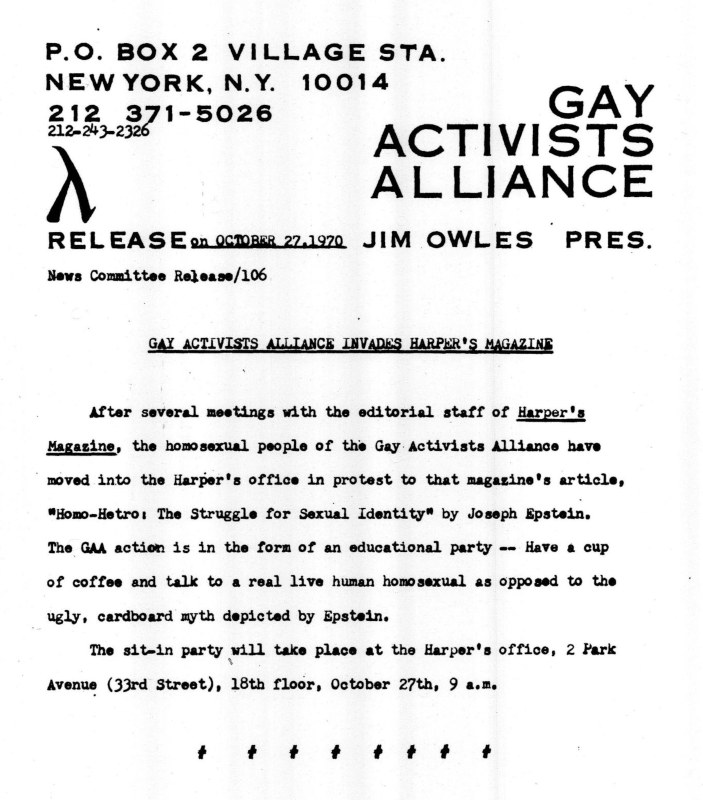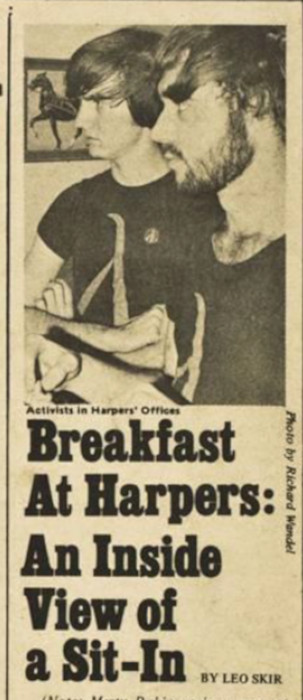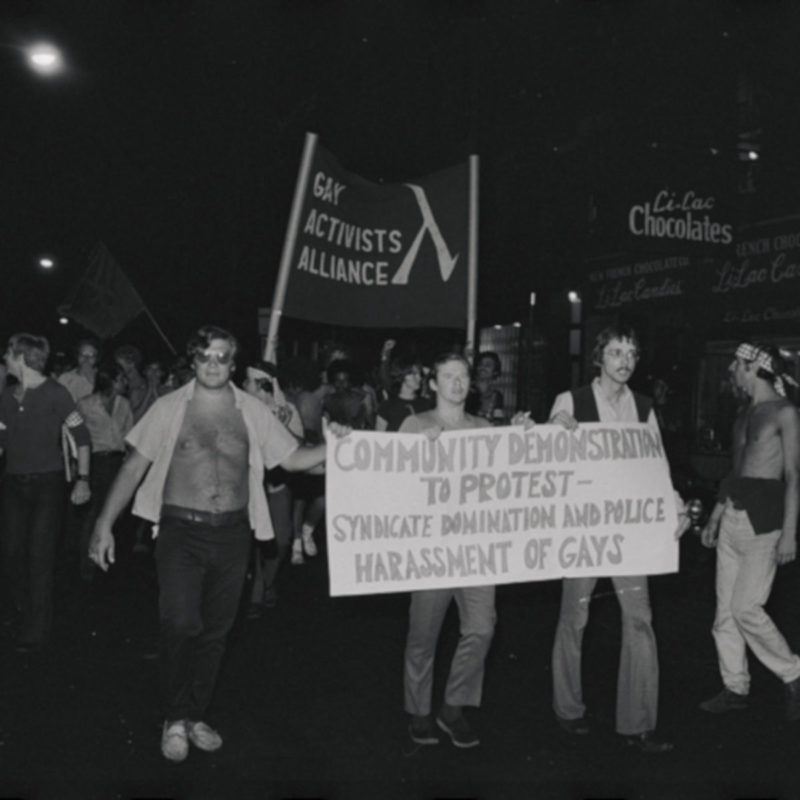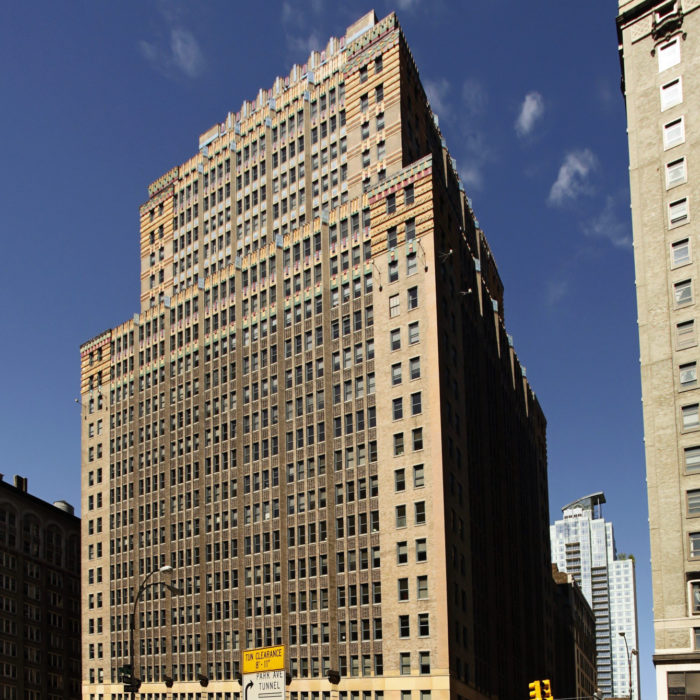
Gay Activists Alliance Zap at Harper’s Magazine Offices
overview
The Gay Activists Alliance held a zap in the form of an all-day sit-in of Harper’s Magazine’s offices on October 27, 1970.
The publication had printed an insulting homophobic cover essay, and not only refused to print an apology but also to print a counter article.
History
In September 1970, the esteemed Harper’s Magazine featured on its cover Homo/Hetero: The Struggle for Sexual Identity, written by essayist Joseph Epstein. His long and rambling, blatantly homophobic screed presented homosexuality as a mental illness:
“If I had the power to do so, I would wish homosexuality off the face of this earth. I would do so because I think it brings infinitely more pain than pleasure to those who are forced to live with it; because I think there is no resolution for this pain in our lifetime, only, for the majority of homosexuals, more pain and various degrees of exacerbating adjustment; and because, wholly selfishly, I find myself completely incapable of coming to terms with it….”
In response, the Gay Activists Alliance (GAA) submitted three articles which Harper’s refused to consider, nor would the publication consider printing an apology or commissioning another article. GAA then planned a zap for October 27, 1970. (See our curated theme for background on the “zap” tactic.)
About a dozen GAA members, including president Jim Owles, Vito Russo, Morty Manford, Arnie Kantrowitz, Arthur Evans, John O’Brien, and Pete Fisher (who chaired GAA’s action committee for this zap), as well as Daughters of Bilitis president Ruth Simpson, invaded the 18th-floor offices of Harper’s. They brought along a news crew from WOR-TV. Arriving early in the morning with coffee, donuts, and cookies, members sang gay liberation songs, and leafleted inside, with others outside the building, inviting people to a gay liberation party. GAA leaflets titled “WHAT ARE HOMOSEXUALS LIKE?” intended to counter the heterosexist narrative of the essay. When Evans confronted editor Midge Decter for publishing the essay, she denied that there was any anti-gay prejudice. The sit-in lasted until around 4:00 p.m.
The Harper’s zap ended up having a positive effect in a number of ways. It was covered by ABC-TV and WNEW-TV, and led to a three-part series on gay liberation by WOR-TV. Merle Miller, a former editor at Harper’s, was so appalled by the article that he came out publicly and wrote his own long article, now considered a landmark of American journalism, “What It Means to Be a Homosexual” published in the New York Times Sunday Magazine on January 17, 1971. “I am sick and tired,” he said of the article, “of reading and hearing such goddamn demeaning, degrading bullshit about me and my friends.”
The editors of Harper’s eventually reversed its stance towards homosexuality. Epstein never discounted his essay, and years later Dicter would contribute her own homophobic writing to her conservative husband Norman Podhoretz’s magazine Commentary.
Read about other GAA actions, listed in chronological order, in our curated theme.
Entry by Jay Shockley, project director (August 2020).
NOTE: Names above in bold indicate LGBT people.
Building Information
- Architect or Builder: Ely Jacques Kahn of Buchman & Kahn
- Year Built: 1926-28
Sources
Arthur Bell, Dancing the Gay Lib Blues: A Year in the Homosexual Liberation Movement (New York: Simon & Schuster, 1971), 131-135.
Claude Summers, “Homophobic Author Fears ‘Noted Homophobe’ Will Be Carved on His Tombstone,” The New Civil Rights Movement, July 13, 2016, bit.ly/30GRtYk.
David Carter, Stonewall: the Riots That Sparked the Gay Revolution (New York: St. Martin’s Press, 2004), 251.
Emily Greenhouse, “Merle Miller and the Piece That Launched a Thousand ‘It Gets Better’ Videos,” The New Yorker, October 11, 2012.
Gay Activists Alliance, Meeting Minutes, October 29, 1970.
Gay Activists Alliance, Harper’s Magazine Zap press release and “Statement on Harper’s Magazine,” October 27, 1970.
Gay Liberation Front, “Happy Homos Hit Harpers,” Gay Flames, November 14, 1970.
Leo Skir, “Breakfast at Harpers: An Inside View of a Sit-In,” GAY, November 23, 1970, 1, 10.
Merle Miller, “What It Means to Be a Homosexual,” The New York Times, January 17, 1971, SM9.
Morty Manford and Arthur Evans, “The Theory and Practice of Confrontation Tactics,” GAY, February 12, 1973, 19.
Will Kohler, “Gay History – October 27: Sigmund Freud’s Famous Letter, The GAA Invades Harper’s Magazine and the Tragic Murder of Gay Sailor Allen Schindler,” Back2Stonewall, October 27, 2019, bit.ly/2ZY5W2K.
Do you have more information about this site?
This project is enriched by your participation! Do you have your own images of this site? Or a story to share? Would you like to suggest a different historic site?
